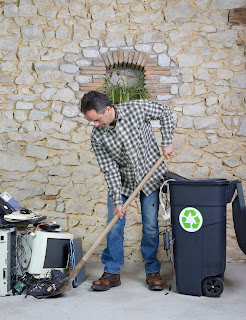 We know it is not easy to make changes, especially to the computer that you are familiar with working on, but now that it’s about to lose
vital security update support... It’s time
to move on! Windows 10 offers a significant upgrade in user productivity and
security support, which will make the upgrade worth the cost for many
companies.
We know it is not easy to make changes, especially to the computer that you are familiar with working on, but now that it’s about to lose
vital security update support... It’s time
to move on! Windows 10 offers a significant upgrade in user productivity and
security support, which will make the upgrade worth the cost for many
companies.
If you’re facing an upgrade
from Windows 7, here are several answers to the most common questions we get
asked about and what EOL means for you.
Is there a Difference Between End of Mainstream
Support & End of Extended Support?
- Mainstream support includes feature updates, security updates, technical support and the ability to make feature requests. It is typically active for the first 5 years of a product’s lifecycle. Mainstream Support ended for Windows 7 on January 13, 2015.
- Extended support still keeps some feature updates patching, along with those critical security updates. You lose the ability to make feature requests and some support options, but not all. Once Extended Support ends, ALL support is gone, including security updates.
Can I Keep Using Windows 7 After January 14, 2020?
Yes, but you’d be leaving your business at serious risk for a data breach.
There’s a connection between outdated software and compromised devices and networks. The famous WannaCry ransomware attack that impacted hundreds of thousands of systems in 2017 was studied, and it was found that nearly 70% of infected systems were running outdated software, Windows 7 to be exact.
Here’s what you’re facing if you keep running Windows 7 after it loses all support:
- More significant risk of data breaches & malware infections.
- Any new software will be less likely to work properly.
- New printers, hardware or other devices will have a difficult time functioning.
- Technology is always advancing and you’ll be left behind.
- Technical support will be hard to find. Tech's don't want to be the last one to touch an old machine that is at risk of being breached.
If you have had that computer
around the office for a long time, you may have a few problems trying to update your
computers to Windows 10. The old machine
will need to meet the minimum requirements to support the new Operating System
(OS).
Windows 10 requirements include:
- It should have the latest version of either Windows 7 SP1 or Windows 8.1 Update.
- Processor: 1 GHz or faster or SoC
- RAM: 1 GB for 32-bit or 2GB for 64-bit
- Hard disk space: 16 GB for 32-bit or 20 GB for 64-bit
- Graphics card: DirectX 9 or later with WDDM 1.0 driver
- Display: 800 x 600
What About Windows 8? Will It Go EOL?
If you are running Windows 8,
then you’ll have a few more years before Microsoft support stops. The Windows 8 EOL date
is January 10, 2023.
Will Internet Explorer (IE) On Windows 7 Be Supported?
No, support for Internet
Explorer on Windows 7 computers will also be discontinued on January 14, 2020.
How Do I Get A Free Upgrade To Windows 10?
If you are working with 10D Tech
and our Managed IT Support: Full Subscription, we include upgrades to
the Windows 10Pro Operating system on approved and verified computers.
If I Can’t Upgrade in Time, Do I Have Any Other
Support Options?
Wellllll … Yes, Microsoft has created
a lifeline for users of Windows 7 Professional and Windows 7 Enterprise because
you are not the only one who has put off making the change. However, it will
cost you! You can purchase extended security updates through
January 2023, but why? For about the cost of paying for the extended support, you can refresh your work stations to brand new. We have some
really great solutions that will bring your networks up to date, refresh your
technology and keep you working without the worry of your computer left alone
out in the world of Bad Guys like a single antelope on the Sahara surround by a
pack of Jackals. Unfortunately for the Windows 7 Home version – NO!
Which Windows Operating System Am I Running?
Windows 7
- Select the Start button, type Computer in the search box, right-click on Computer, and then select Properties.
- Under Windows edition, you'll see the version and edition of Windows that your device is running.
Windows 8
- To find out which version of Windows your device is running, press the Windows logo key + R, type winver in the Open box, and then select OK.
- If you're using a touch device, swipe in from the right edge of the screen, tap Settings, and then tap Change PC settings. Continue to step 3.
- If you're using a mouse, point to the lower-right corner of the screen, move the mouse pointer up, click Settings, and then click Change PC settings.
- Select PC and devices & PC info.
- Under Windows, you'll see which edition and version of Windows your device is running.
- Under PC & System type you'll see if you're running a 32-bit or 64-bit version of Windows
Windows 10
- To find out which version of Windows your device is running, press the Windows logo key + R, type winver in the Open box, and then select OK.
- Select the Start button & Settings & System > About
- Under Device specifications & System type, see if you're running a 32-bit or 64-bit version of Windows
- Under Windows specifications, check which edition and version of Windows your device is running







